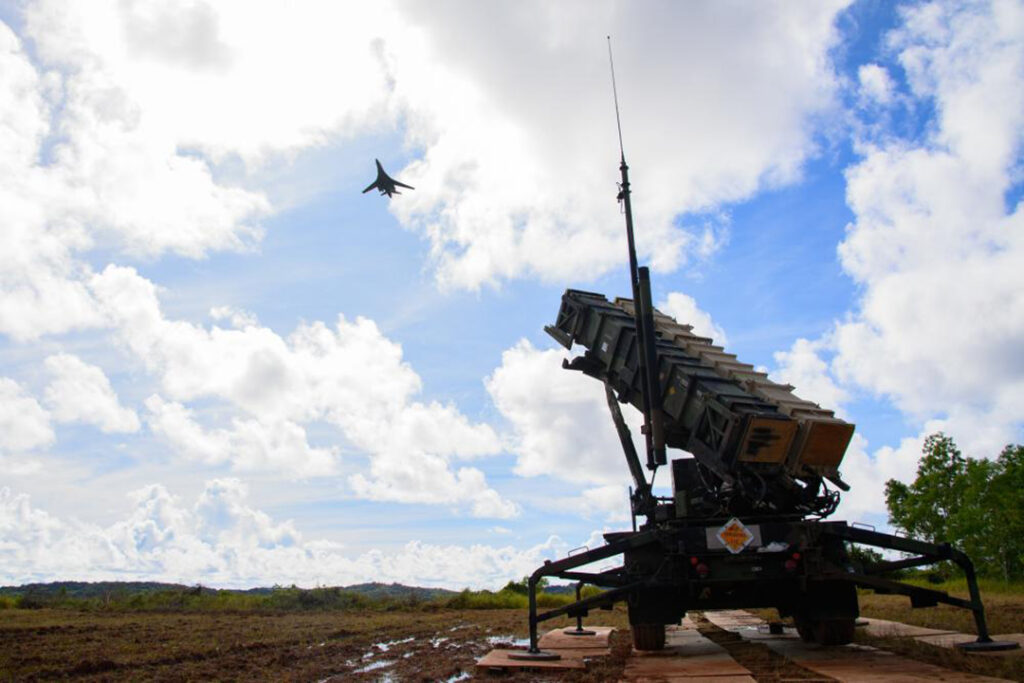U.S. STRATEGIC COMMAND
United States military forces demonstrated the might of their integrated deterrence during Valiant Shield 2022 (VS22), the joint Indo-Pacific region exercise held at sea, in the air, on land and in cyberspace.
The biennial U.S. event conducted June 6-17 included 15 surface ships, more than 200 aircraft and an estimated 13,000 personnel from the Navy, Air Force, Army, Marine Corps and Space Force. Valiant Shield was conducted on the Commonwealth of the Northern Mariana Islands, Guam, Palau and at sea around the Mariana Island Range Complex.
The participating forces from U.S. Strategic Command (USSTRATCOM) included
B-1B Lancer long-range bombers and Army Patriot missile defense batteries. VS22 demonstrates how diverse U.S. military assets can seamlessly operate as part of an integrated deterrence that is crucial in regions that face military coercion from nations such as the People’s Republic of China (PRC) and North Korea.
(Pictured: A U.S. Air Force B-1B Lancer assigned to the 34th Expeditionary Bomb Squadron flies over a PAC-2 Patriot interceptor battery of the 38th Defense Artillery Brigade on June 12 at Palau International Airport.)
The PRC has spent years building up its nuclear and conventional arsenal in an attempt to project power and influence in the Pacific and prevent the U.S. from intervening in regional conflicts. It now possesses the world’s largest missile arsenal, which can strike targets in the South and East China seas and as far east as the U.S. territory of Guam.
Beijing is “watching the war in Ukraine closely and will likely use nuclear coercion to their advantage in the future. Their intent is to achieve the military capability to reunify Taiwan by 2027, if not sooner,” warned U.S. Navy Adm. Charles Richard, commander of USSTRATCOM, during testimony to the U.S. Senate in May 2022. This projection, while in line with previous statements from U.S. leadership, represents an acceleration of a PRC threat that was commonly estimated to be in the 2030s. In August 2021, Richard publicly characterized the PRC’s explosive military buildup as a “breathtaking strategic breakout” and issued a call to action, warning that “business as usual will not work.”
The Indo-Pacific region also faces the threat of potential aggression from the rapid military modernization of North Korea, especially from nuclear missiles. North Korea’s missile development encompasses short- to intercontinental-range weapons, utilizing cruise, submarine-launched and even hypersonic technologies.
In the face of these threats, the U.S. maintains strong regional alliances and a dynamic military posture whose mission is to defend international norms. Exercises such as VS22 are critical to the U.S. ability to integrate capabilities and successfully operate across domains and distance. This importance has been clearly evident in Russia’s failures to achieve military objectives in its invasion of Ukraine despite having an overwhelming advantage in forces.
The big picture for U.S. military deterrence is that it promotes regional security and stability through offensive and defensive forces while using nuclear and conventional weapons. For example, the strategic bomber deployments of B-52s, B-1s and B-2s illustrate the unmatched reach of the U.S. Air Force. The B-1s, stationed in the continental U.S. at Ellsworth Air Force Base in South Dakota, are capable of rapidly deploying to any location across the globe. The bombers provide a presence that reassures allies and partners.
The bomber task force, as each mission is called, is rapid and flexible depending on need and objective. The current B-1B deployment to Guam and participation in VS22 showcases the bombers’ global strike capabilities and sends a powerful signal that the island is an unambiguous part of the U.S. and will be defended as such.
Likewise, rapidly relocatable missile defenses send a similar message. One of the premier air- and missile-defense platforms in the U.S. arsenal, the Patriot, was deployed to Guam and Palau for VS22. Other missile systems that are, or have been, deployed in the lndo-Pacific region include the Terminal High Altitude Area Defense and the U.S./lsraeli-developed Iron Dome.
Defending Guam, or any other area from air and missile attack depends on overlapping and complementary layers of protection. This takes redundant and mutually supportive capabilities that maximize opportunities to defeat attacks. A variety of radars and other sensors work in concert with interceptor systems to counter threats. The goal is to field a system that can use any available sensors to engage a target with the most appropriate and best-positioned asset. Leveraging this approach across the region and beyond produces an integrated deterrence framework across every warfighting domain: air, land, maritime, space and cyber.
The U.S. is unwavering in its commitment to established norms and international agreements adhered to by responsible nations. Measured deployments of highly visible weapons to key areas around the globe, such as those during VS22, send a clear message to allies, partners and potential adversaries of the integrated U.S. capability ready to defend its interests.
IMAGE CREDIT: SENIOR AIRMAN JOSE MIGUEL T. TAMONDONG/U.S. AIRFORCE

